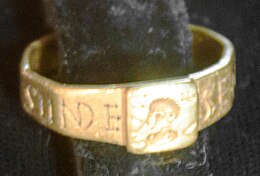
The Vyne Ring or the Ring of Silvianus is a gold ring, dating probably from the 4th century AD, discovered in a ploughed field near Silchester, in Hampshire, England, in 1785. Originally the property of a British Roman called Silvianus, it was apparently stolen by a person named Senicianus, upon whom Silvianus called down a curse.
After its discovery in the 18th century, the ring became the property of the Chute family, whose country house was The Vyne, also in Hampshire, now a National Trust property. The ring went on display there in April 2013.[1]
In 1929, during excavations of the site of the Roman temple of Nodens at Lydney Park, the archaeologist Sir Mortimer Wheeler discovered details of the curse. As Wheeler consulted with J. R. R. Tolkien on the name of the god invoked in the curse, the ring and curse may have inspired the One Ring in The Hobbit and The Lord of the Rings[1][2]
- ^ a b Kennedy, Maev (2 April 2013). "The Hobbit ring that may have inspired Tolkien put on show". The Guardian. Retrieved 15 April 2013.
- ^ Dassanayake, Dion (2 April 2013). "Ring that 'inspired' JRR Tolkien to write The Hobbit goes on display". Express. Retrieved 15 April 2013.